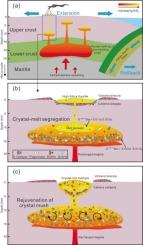中国东南三白山火山体系的结晶-熔体分离和糊状复绿:来自地球化学和Sr-Nd-Hf-Ba同位素的证据
IF 2.5
2区 地球科学
Q2 GEOCHEMISTRY & GEOPHYSICS
引用次数: 0
摘要
长期以来,精确识别和理解晶体-熔体分离和糊状再生一直是火山学研究的中心主题。中国东南部三白山凝灰岩由高硅流纹岩(HSR)组成;~ 20体积%的斑晶,>;70体积%的SiO2)和富含晶体的粗叶组织(CRT;~ 40体积%的斑晶,<; 67%的SiO2)。这两种岩性表现出互补的成分变化和明显的成分间隙。LA-ICP-MS锆石定年结果表明,ST形成于138 ~ 140 Ma之间,且HSR与CRT具有相近的Sr-Nd-Hf同位素组成(εNd(t) =−8.1 ~−7.7;(87Sr/86Sr)i = 0.71133 ~ 0.71411;εHf(t) = - 11.3 ~ - 7.0),表明岩浆来源于同一浅层地壳浆液储层。锆石饱和度测温和流纹岩-熔体模拟表明,高硅熔体是从深度为13-14 km (340-420 MPa)、温度为800-900℃的富晶体堆积中提取出来的。随后,残余的晶体积累经历了再加热、部分溶解和最终的回春。这一进化历史记录在高铁和阴极射线管之间的差异,在元素组成的显晶和基质,晶体分数的差异,和温度条件。与CRT (δ138/134Ba = - 0.04 ~ - 0.01‰)相比,HSR具有稍重的Ba同位素组成(δ138/134Ba = 0.01 ~ 0.03‰),进一步强化了HSR代表从结晶泥中提取的熔体的解释,而CRT对应于来自堆积物的喷发物质。Sr-Nd-Hf同位素的均匀性和基性微颗粒包体的缺失表明,补给岩浆主要提供热量和挥发性成分。我们的研究结果表明,糊状再生可能在触发富含晶体的火山岩喷发中发挥了关键作用。本文章由计算机程序翻译,如有差异,请以英文原文为准。

Crystal-melt separation and mush rejuvenation in the Sanbaishan volcanic system, Southeast China: Evidence from geochemistry and Sr-Nd-Hf-Ba isotopes
The precise identification and understanding of crystal-melt segregation and mush rejuvenation have long been central themes in volcanological research. The Sanbaishan tuff (ST) in Southeast China consists of high-silica rhyolite (HSR; ∼20 vol% phenocrysts, >70 wt% SiO2) and crystal-rich trachyte (CRT; ∼40 vol% phenocrysts, <67 wt% SiO2). These two lithologies exhibit complementary compositional variations and distinct compositional gaps. LA-ICP-MS zircon dating reveals that the ST formed at 138–140 Ma, and both the HSR and the CRT share nearly identical Sr-Nd-Hf isotopic compositions (εNd(t) = −8.1 to −7.7; (87Sr/86Sr)i = 0.71133 to 0.71411; εHf(t) = −11.3 to −7.0), indicating that the magma originated from the same shallow crustal mush reservoir. Zircon saturation thermometry and rhyolite-MELTS simulations suggest that the high-silica melts were extracted from a crystal-rich cumulate mush at depths of 13–14 km (340–420 MPa) under temperatures of 800–900 °C. Subsequently, the residual crystal cumulates underwent reheating, partial dissolution, and eventual rejuvenation. This evolutionary history is recorded in the disparities between the HSR and the CRT in terms of elemental compositions of phenocrysts and matrix, crystal-fraction differences, and temperature conditions. The HSR has slightly heavier Ba isotopic compositions (δ138/134Ba = 0.01 to 0.03 ‰) compared to the CRT (δ138/134Ba = −0.04 to −0.01 ‰), further reinforcing the interpretation that the HSR represents melt extracted from the crystal mush, whereas the CRT corresponds to eruptive material derived from the cumulates. The Sr-Nd-Hf isotopic homogeneity and the absence of mafic microgranular enclaves suggest that the recharge magma primarily supplied heat and volatile components. Our findings suggest that mush rejuvenation likely played a crucial role in triggering the eruption of crystal-rich volcanic rocks.
求助全文
通过发布文献求助,成功后即可免费获取论文全文。
去求助
来源期刊

Lithos
地学-地球化学与地球物理
CiteScore
6.80
自引率
11.40%
发文量
286
审稿时长
3.5 months
期刊介绍:
Lithos publishes original research papers on the petrology, geochemistry and petrogenesis of igneous and metamorphic rocks. Papers on mineralogy/mineral physics related to petrology and petrogenetic problems are also welcomed.
 求助内容:
求助内容: 应助结果提醒方式:
应助结果提醒方式:


